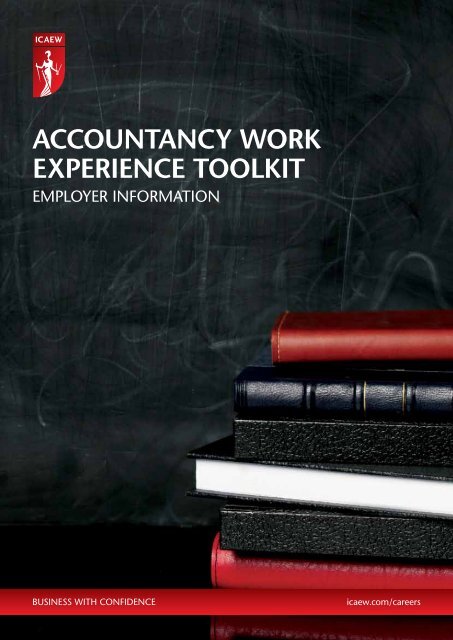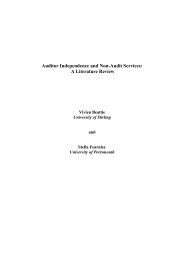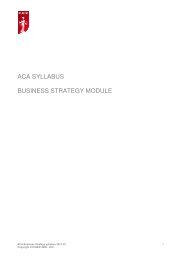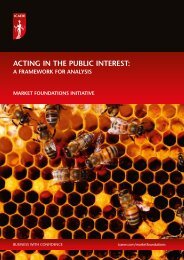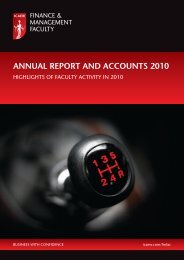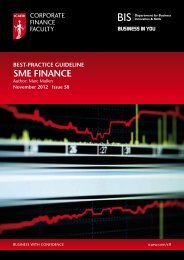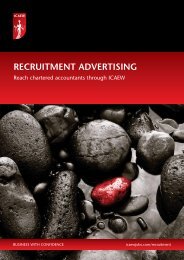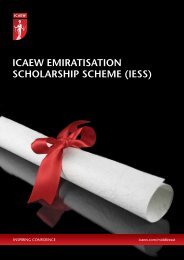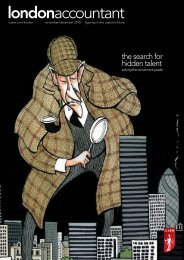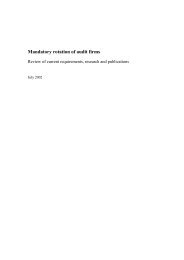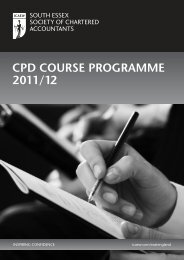ACCOUNTANCY WORK EXPERIENCE TOOLKIT - ICAEW
ACCOUNTANCY WORK EXPERIENCE TOOLKIT - ICAEW
ACCOUNTANCY WORK EXPERIENCE TOOLKIT - ICAEW
You also want an ePaper? Increase the reach of your titles
YUMPU automatically turns print PDFs into web optimized ePapers that Google loves.
<strong>ACCOUNTANCY</strong> <strong>WORK</strong><br />
<strong>EXPERIENCE</strong> <strong>TOOLKIT</strong><br />
EMPLOYER INFORMATION<br />
BUSINESS WITH confidence<br />
icaew.com/careers
contents<br />
SECTION<br />
Page<br />
1 Introduction 01<br />
2 Work experience 02<br />
What is work experience 02<br />
Benefits to organisations 02<br />
Benefits to students 03<br />
Designing a work experience placement 03<br />
How to get started 04<br />
Becoming an Authorised Training<br />
Employer (ATE) 04<br />
3 Organisation information 05<br />
Guidance for organisations 05<br />
Suggested work experience placement<br />
Week one 06<br />
Week two 06<br />
Day one – Introduction 06<br />
4 Useful addresses and websites 07<br />
Further reading 07<br />
5 Acknowledgements 07<br />
APPENDICES<br />
Page<br />
A Checklist for organisation’s briefing<br />
TO studENTS 08<br />
General 08<br />
Workplace hazards 08<br />
Safety precautions 08<br />
Emergency procedures 08<br />
B Suggested answers to Supplementary<br />
Question Bank 10<br />
Basic bookkeeping 11<br />
Accruals and prepayments questions 13<br />
C Suggested answers to case study –<br />
Activities 1 to 5 14<br />
Worksheet 1 Payments listing 14<br />
Worksheet 2 Payments cash book 15<br />
Worksheet 3 Petty cash book 16<br />
Worksheet 4 Receipts listing 17<br />
Worksheet 5 Receipts cash book 18<br />
Worksheet 6 Bank accounts<br />
and reconciliation 19<br />
Worksheet 7 Extract from bank statement 20<br />
Worksheet 8 Fixed asset register 21<br />
Worksheet 9 VAT account 22<br />
Worksheet 10 Trial balance 23<br />
Worksheet 11 Profit and loss account 24<br />
Worksheet 12 Balance sheet 25<br />
© <strong>ICAEW</strong> 2012
1 Introduction<br />
The successful future of all businesses<br />
depends on high quality employees.<br />
So it’s important that organisations and<br />
educational establishments work together<br />
to ensure that students are properly<br />
prepared for the world of work, with<br />
the necessary skills and motivation.<br />
One key way in which organisations and local schools can<br />
collaborate is through work experience placements for<br />
students. Such placements offer many benefits and<br />
opportunities: students can develop their knowledge and<br />
understanding of the world of work; and organisations<br />
can help students learn about the skills and attitudes<br />
expected by a business, and raise their awareness of the<br />
various career opportunities on offer.<br />
<strong>ICAEW</strong> is fully aware that today’s school students are<br />
tomorrow’s business advisers. So we have put together<br />
this toolkit to help you develop a finance-related work<br />
experience placement for students in their last two years<br />
of compulsory schooling. It is made up of two parts:<br />
• employer’s information<br />
• student’s information.<br />
Both toolkits include lots of information about the<br />
placement, as well as a series of activities and worksheets.<br />
(We recommend that you photocopy or download<br />
the student information so that you can re-use the<br />
activity sheets.)<br />
Students should work through the activities during<br />
their time with you, asking you and your colleagues for<br />
help along the way. Although they can complete the<br />
hardcopy worksheets, they will learn more by creating<br />
their own spreadsheets on a PC.<br />
The employer toolkit includes the same worksheets,<br />
but with the answers, in red.<br />
Although this toolkit provides a structured guide for<br />
work experience students it is not a step-by-step guide<br />
to designing a work experience programme, nor does<br />
it give guidance on the legal aspects of these<br />
programmes and placements. We recommend that<br />
you also consult your local Education Business Link<br />
Consortia, Local Education Authority (LEA), Skills<br />
Funding Agency (SFA) or other similar organisations<br />
for more detailed and/or local guidance on work<br />
experience placements. You will find a list of useful<br />
contacts in Sections 4 and 5.<br />
Work Experience Toolkit – Employer Information<br />
01
2 work experience<br />
WHAT IS <strong>WORK</strong> <strong>EXPERIENCE</strong>?<br />
According to the DCSF Work Experience: A guide<br />
for employers, work experience may be defined as:<br />
A placement on employer’s premises in which a<br />
student carries out a particular task or duty, or a<br />
range of tasks or duties, more or less as would an<br />
employee, but with the emphasis on the learning<br />
aspects of the experience.<br />
Work experience is governed by the Education<br />
Act 1996, as amended by the School Standards<br />
& Framework Act 1998. The main features of work<br />
experience are:<br />
• only students in their last two years of compulsory<br />
schooling, or students taking post-16 courses,<br />
are eligible;<br />
• placements occur on employers’ premises; and<br />
• the vast majority of pre-16 placements last for<br />
one or two weeks, but post-16 placements can be<br />
more varied in length depending on the course<br />
being followed.<br />
Placements are more likely to be successful if<br />
they provide a genuine opportunity, both for<br />
the employer and the student. So you will need<br />
to consider:<br />
• time and resources available;<br />
• which departments, activities and roles<br />
are suitable;<br />
• health and safety;<br />
• how complex the tasks are, how long they will take<br />
to complete;<br />
• when will placements cause the least disruption;<br />
and<br />
• when do education establishments in your local area<br />
release students for placements.<br />
BENEFITS TO ORGANISATIONS<br />
There are several benefits of these programmes for<br />
employers, including raising your profile among<br />
schools and potential future employees and<br />
consequently improving the number of quality<br />
students applying for your vacancies in the future.<br />
The type of programme you will be able to offer will<br />
depend upon the nature and size of your organisation.<br />
The education establishment you are working with will<br />
need to consider how the experience relates to the<br />
student’s work at school.<br />
I would like to take this opportunity to say Thank You very much<br />
for allowing us to trial the Accountancy Work Experience Toolkit.<br />
We do struggle to find appropriate work and time to supervise<br />
as this is normally a very busy time of year for us. Therefore this<br />
did help us a lot this year … It is always difficult to give work<br />
experience pupils a flavour of what accountants do in such a<br />
short period of time and this was certainly a useful first taste.<br />
Sarah Risdon, Potter Baker Chartered Accountants<br />
02<br />
© <strong>ICAEW</strong> 2012
BENEFITS TO STUDENTS<br />
For many students, work experience placements<br />
have a great impact on their personal, social and career<br />
development. It helps them develop financial capability<br />
and technical skills, as well as developing creativity,<br />
risk-taking, and the drive to make ideas happen.<br />
For many school students, the adult workplace is a<br />
great unknown. So a big benefit of a placement is<br />
enabling a young person to experience the world of<br />
work first hand. Any placement should be designed<br />
to help young people to:<br />
• prepare for working life by learning to meet<br />
the appropriate standards of company behaviour<br />
(eg, time keeping, dress sense, conduct and the<br />
business culture/ethos);<br />
• learn general work-related, transferable skills that<br />
can be developed over the course of the placement;<br />
• learn about the way a business operates, its jobs<br />
and working conditions, and the rights and<br />
responsibilities in the workplace;<br />
• develop an understanding of work and/or skills<br />
needed for enterprise and employability;<br />
• undertake a range of tasks as an employee<br />
would; and<br />
• learn about a specific industry, or sector, which will<br />
help them make informed career choices.<br />
DESIGNING A <strong>WORK</strong> <strong>EXPERIENCE</strong> PLACEMENT<br />
Work placements should include three main types<br />
of activity:<br />
• work shadowing<br />
• helping staff with tasks that can be easily delegated<br />
• structured activities – small projects that can be<br />
completed independently.<br />
Work shadowing<br />
Shadowing individual members of staff gives the<br />
student a varied and interesting overview of your<br />
company’s work, while causing minimal disruption<br />
to your company’s routine. It is particularly effective if<br />
interesting events and meetings are taking place while<br />
the student is there. Ideally, you should arrange a<br />
schedule that lets the student spend time with staff<br />
in different departments. If structured carefully,<br />
the student will gain an excellent overview of the<br />
organisation’s work, observing meetings and events<br />
that have taken place as part of the organisation’s<br />
normal work.<br />
Delegated tasks<br />
Many of the objectives of a work placement are met<br />
by a student:<br />
• spending time in the workplace<br />
• observing how the organisation operates<br />
• participating in routine activities.<br />
So you can legitimately include routine administrative<br />
tasks in the placement. It is perfectly reasonable to<br />
expect a student to spend time helping with tasks such<br />
as opening and sorting post, filing documents, ordering<br />
stationery, preparing meeting papers, and so on.<br />
Students also benefit from learning to use office<br />
equipment that they may not encounter in other<br />
environments so, again, it’s perfectly reasonable for<br />
you to ask them to help with photocopying, franking<br />
mail, laminating, faxing and other tasks. They can<br />
also benefit from using ICT skills in a professional<br />
environment so they could help you with data entry,<br />
preparing presentations or mail merges.<br />
These sorts of activities should only take up<br />
a proportion of the student’s time, but don’t<br />
underestimate the value to you of having an extra<br />
pair of hands in a busy office.<br />
Structured activities<br />
As well as giving a focus to the placement, these are<br />
useful for the times when your staff are busy with their<br />
own work.<br />
Structured projects and activities enable students to<br />
learn key skills such as working independently, project<br />
planning, time management, report writing, practical<br />
research and using IT in the workplace. They are also<br />
similar to the type of tasks that entry-level staff might<br />
have to do.<br />
This <strong>ICAEW</strong> Accountancy Work Experience Toolkit<br />
provides structured activities for students undertaking<br />
a one or two week work experience placement. They<br />
cover some of the basic accountancy activities, based<br />
on a fictitious company. You have the answers in your<br />
employer information.<br />
Work Experience Toolkit – Employer Information<br />
03
Don’t forget that there is more to work than projects<br />
and activities. Try to include your student in some of<br />
the following:<br />
• work shadowing<br />
• work observation or visits<br />
• work-based projects<br />
• company briefings<br />
• mock interviews<br />
• mentoring.<br />
HOW TO GET STARTED<br />
Once you have decided to offer work experience<br />
placements, the first thing you should do is contact<br />
the education manager of your local Learning and Skills<br />
Council (LSC) or local Education Business Link (EBL)<br />
consortia about the arrangements in place in your<br />
local area.<br />
Demand is high for work experience placements and in<br />
most areas, the EBL consortia, Trident organiser or even<br />
our Student Recruitment Team will liaise between local<br />
education establishments seeking placements and<br />
organisations offering them. These organisations can<br />
also give you help and advice on all aspects of work<br />
experience programmes and placements, and help you<br />
to recruit suitable students.<br />
Once you have confirmed what arrangements are<br />
in place in your local area, you can then make direct<br />
contact with the education establishment or local<br />
coordinating agency and meet with the relevant<br />
teacher or contact to clarify your mutual aims and<br />
objectives.<br />
It’s vital that you plan the placement carefully so that<br />
it happens smoothly, with minimum disruption to your<br />
normal working practices, and so that the student can<br />
get as much out of it as possible. When planning your<br />
placement you should consider:<br />
• dates and duration<br />
• location and hours of work<br />
• duties and responsibilities of the post<br />
• dress and conduct<br />
• arrangements for transport and meals<br />
• position regarding Employers’ Liability and Public<br />
Liability policies<br />
• risks and control measures<br />
• confirmation of any mid-placement visit by a<br />
representative of the school<br />
• name and telephone number of the student’s line<br />
manager<br />
• name and telephone number of the contact at the<br />
workplace in case of difficulties.<br />
Becoming an Authorised training<br />
employer (ATE)<br />
If you want to train ACA students, authorisation is<br />
usually free and is not an overly time-consuming<br />
process. The authorisation process helps ensure all<br />
students, wherever they train, receive the same levels<br />
of support and guidance. Visit icaew.com/employers<br />
for more details.<br />
The toolkit is a useful tool enabling students to gain an introduction<br />
to accountancy/bookkeeping. It enables them to understand more<br />
the work they carry out as their placement progresses. It also prevents<br />
the student being used as free labour for number crunching activities<br />
and general utilisation.<br />
David Cornish, Thomas Westcott Chartered Accountants<br />
04<br />
© <strong>ICAEW</strong> 2012
3 ORGANISATION INFORMATION<br />
GUIDANCE FOR ORGANISATIONS<br />
The activities in the student information toolkit take<br />
students through a series of activities and questionnaires<br />
that they should do during their work experience<br />
placement in an accountancy firm or department.<br />
The various exercises are designed to introduce them to:<br />
• accounts preparation which forms the basis of much<br />
of the work in an accountancy function; and<br />
• specific concepts and terminology used<br />
by accountants.<br />
The main activities are based around a case study<br />
company called Props ‘n’ Frocks Limited which sells<br />
fancy dress costumes. The company’s year end is<br />
31 July 20XX and students are asked to carry out some<br />
of the accounts preparation work in order to put<br />
together a profit and loss account for the month to<br />
31 July 20XX and a balance sheet as at 31 July 20XX.<br />
The tasks are not supposed to be a test and we<br />
encourage students to ask questions along the way.<br />
The tasks that your student will be asked to carry out<br />
are contained within the student’s information toolkit;<br />
we recommend that you keep a copy of this for your<br />
own records. The model answers to the activities<br />
and questions are shown in the appendices to this<br />
employer’s guide. You can choose whether to give<br />
out the answers after each stage of the accounts<br />
preparation process, or at the end of the week when<br />
the student has completed the case study.<br />
As well as the structured activities, there are additional<br />
questions included in the student’s information toolkit<br />
which are designed to be a stop gap either at the end<br />
of each day as suggested in the training plan, or at the<br />
end of the week if you prefer. These general questions<br />
build on student information and the work carried out<br />
in the case study. Again, the answers are included in<br />
the appendices to this employer’s guide.<br />
Within the student information toolkit there is<br />
introductory material which explains the types of<br />
business structures, the purpose of keeping accounting<br />
records and introduces a profit and loss account and<br />
balance sheet. It would be helpful to the student if a<br />
member of your staff could show them examples of<br />
client records, an accounts file and the final profit and<br />
loss account and balance sheet.<br />
The tasks have been designed so that the student<br />
can complete them during one week. However, if<br />
the placement is for a fortnight it is easy to expand<br />
the tasks to cover a longer period. As the activities<br />
mirror real-life accounting activities, once a student has<br />
completed a practice activity, it would be helpful if you<br />
could arrange for the student to complete the same<br />
activity on a real client. This could either be done after<br />
each activity, or after the student has completed all of<br />
the practice activities.<br />
Work Experience Toolkit – Employer Information<br />
05
SUGGESTED <strong>WORK</strong> <strong>EXPERIENCE</strong> PLACEMENT – WEEK ONE<br />
DAY ACTIVITY MATERIALS<br />
One<br />
Two<br />
Three<br />
Four<br />
Five<br />
Introduction day<br />
Day one of the work experience is a general introduction day<br />
for the student to your firm, the staff and the work that you do.<br />
We recommend that you arrange for the student to have a tour<br />
of the office and a health and safety induction.<br />
• Explain the plan for the week or two-week period<br />
• Induction questionnaire<br />
• Information on accounting in business<br />
• What are accounting records?<br />
• Why does a business have to prepare accounts?<br />
• What goes in an accounts preparation file?<br />
• What is a profit and loss account?<br />
• What is a balance sheet?<br />
• All about VAT<br />
Activity one<br />
• Recording transactions<br />
• Begin supplementary questions<br />
Activity two<br />
• Balancing off and reconciling<br />
• Supplementary questions<br />
Activity three<br />
• Fixed assets and depreciation<br />
Activity four<br />
• VAT<br />
• Supplementary questions<br />
Activity five<br />
• Trial balance<br />
• Complete supplementary questions<br />
Student toolkit – section 3<br />
Student toolkit – section 4<br />
Student toolkit – section 5<br />
Student toolkit – section 6<br />
Student toolkit – section 7<br />
Student toolkit – section 6<br />
Student toolkit – section 7<br />
Student toolkit – section 6<br />
Student toolkit – section 6<br />
Student toolkit – section 7<br />
Student toolkit – section 6<br />
Student toolkit – section 7<br />
WEEK TWO<br />
If the student is completing two weeks of work experience, consider letting them build on the initial accounts work<br />
done in the case study by allowing them to carry out the initial analysis work and bank reconciliation on a real client<br />
or business situation.<br />
06<br />
© <strong>ICAEW</strong> 2012
4 USeFUL ADDRESSES AND WEBSITES<br />
ADDRESSES<br />
Accountancy Learning Ltd<br />
Southernhay Lodge<br />
Barnfield Crescent<br />
Exeter<br />
EX1 1QT<br />
www.accountancylearning.co.uk<br />
DCSF Publications<br />
Prolog<br />
Sherwood Park<br />
Annesley<br />
Nottingham NG15 0DJ<br />
T 0845 600 8147<br />
F 0845 603 3360<br />
E DCSF@prologistics.co.uk<br />
www.dfes.gov.uk/publications<br />
Department for Education<br />
Castle View House<br />
East Lane<br />
Runcorn<br />
Cheshire<br />
WA7 2GJ<br />
T +44 (0)1928 794248<br />
www.education.gov.uk<br />
Health & Safety Executive (HSE)<br />
Rose Court<br />
2 Southwark Bridge<br />
London SE1 9HS<br />
T +44 (0)207 717 6000<br />
F +44 (0)207 717 6417<br />
www.hse.gov.uk<br />
<strong>ICAEW</strong><br />
Student Recruitment<br />
Metropolitan House<br />
321 Avebury Boulevard<br />
Milton Keynes<br />
MK9 2FZ<br />
icaew.com/careers<br />
Skills Funding Agency<br />
Cheylesmore House<br />
Quinton Road<br />
Coventry<br />
CV1 2WT<br />
T 0845 377 5000<br />
E info@skillsfundingagency.bis.gov.uk<br />
www.skillsfundingagency.bis.gov.uk<br />
Royal Society for the Prevention<br />
of Accidents (RoSPA)<br />
Edgbaston Park<br />
353 Bristol Road<br />
Edgbaston<br />
Birmingham<br />
B5 7ST<br />
www.RoSPA.com<br />
www.youngworker.co.uk<br />
USEFUL WEBSITES<br />
Department for Business,<br />
Innovations and Skills<br />
www.bis.gov.uk<br />
Young People<br />
www.direct.gov.uk/en/YoungPeople<br />
Federation of Education Business<br />
Links Consortia<br />
www.feblc.org<br />
National Mentoring Network<br />
www.nmn.org.uk<br />
Oxford Cambridge RSA Examinations<br />
(OCR) Work-Related Learning Page<br />
www.ocr.org.uk<br />
FURTHER READING<br />
Work Experience: A guide for employers<br />
DCSF publications<br />
For ordering quote reference:<br />
DCSF-1471-2005<br />
Be Safe! An Introductory guide to Health<br />
and Safety: For Students<br />
LSC Publication<br />
For ordering quote reference:<br />
LSC/AA000/0912/04<br />
Managing health and safety<br />
on Work Experience:<br />
A guide for organisers<br />
HSE Books<br />
For ordering quote reference: HSG199<br />
Work-Related Learning and the Law<br />
DCSF publications<br />
For ordering quote reference:<br />
DCSF-0340-2006<br />
Young People at Work –<br />
A guide for employers<br />
HSE Books<br />
For ordering quote reference: HSG165<br />
5 acknowledgements<br />
<strong>ICAEW</strong> would like to thank Simon Deane FCA,<br />
Sally Antrobus ACA and Claire Eardley of Accountancy<br />
Learning Ltd and APlus Learning Innovations Ltd for<br />
their help in putting together this <strong>ICAEW</strong> Accountancy<br />
Work Experience Toolkit.<br />
Work Experience Toolkit – Employer Information 07
appendix a<br />
checklist for organisation’s briefing to students<br />
This checklist contains some of the common issues<br />
which you should cover in an induction. You may<br />
need to modify or expand it to suit your placement<br />
programme, type of work, or the age range of the<br />
students. It’s often best to do this briefing while<br />
showing the students around the areas which they<br />
are going to visit, or in which they will be working.<br />
GENERAL<br />
Line manager<br />
Explain who will be responsible for the student in the<br />
workplace and ensure that the managers are aware of<br />
their responsibilities under health and safety legislation.<br />
Safety policy<br />
Explain the policy and point out any aspects that apply<br />
to students in particular. Emphasise the student’s<br />
personal responsibilities.<br />
Safety literature<br />
Distribute and explain any relevant safety literature,<br />
taking into account the student’s age, the length of<br />
the placement, and their likely exposure to hazards.<br />
You can find more guidance in the DCSF booklet<br />
Be Safe!, which you can get free of charge from<br />
DCSF Publications.<br />
Key safety people<br />
Introduce them to the student or give them their<br />
names, locations and responsibilities.<br />
Prohibited areas<br />
Tell the student about any areas which they must not<br />
visit for safety reasons and explain why.<br />
<strong>WORK</strong>PLACE HAZARDS<br />
Machinery<br />
Explain to the student that they must never operate<br />
any machine without permission from the supervisor.<br />
They must also never try to repair any machine on<br />
their own, but report all faults to the supervisor.<br />
Dangerous substances<br />
Explain how important it is that everyone complies<br />
with the rules on the handling of chemicals and the<br />
advice given on container labels, as detailed in the<br />
Control of Substances Hazardous to Health Regulations<br />
1999 (COSHH). Ensure that students know they must<br />
ask the supervisor if they are not sure of the<br />
precautions they should take.<br />
Lifting heavy and awkward objects<br />
Any work like this should have been assessed under<br />
the Manual Handling Operations Regulations 1992. If<br />
necessary, arrange for students to be shown the right<br />
way to lift objects and explain why it is important.<br />
Housekeeping<br />
Explain the importance of, for example, keeping<br />
drawers and cupboard doors shut; safe positioning of<br />
loose telephone and computer cables etc; safe storage<br />
of material; keeping the work area clean and tidy.<br />
SAFETY PRECAUTIONS<br />
Safe systems of work<br />
Describe any hazards associated with the work the<br />
students are to do/watch and explain the importance<br />
of safe working practices. Make sure students get any<br />
necessary further briefing before they move on to<br />
something new.<br />
Protective clothing<br />
Where applicable, describe what is provided, when<br />
and why it must be used and how to make any<br />
necessary adjustments.<br />
Safety equipment<br />
Explain when and why it must be used, where it is kept<br />
and how to use it.<br />
Hygiene<br />
Tell students where the lavatories and washing facilities<br />
are. Where applicable, explain the use of barrier creams<br />
etc and tell students where they can be found.<br />
EMERGENCY PROCEDURES<br />
First aid<br />
Explain the first aid facilities and make sure the student<br />
knows who is a first aider.<br />
Accident procedure<br />
Explain that all accidents must be reported and that all<br />
injuries, no matter how small, must be entered in the<br />
accident book. Tell the student where the accident<br />
book is kept and to whom they should report in the<br />
event of any accident.<br />
Fire alarm<br />
Explain what students should do if they discover a fire.<br />
Describe what they will have to do if the alarm is<br />
raised.<br />
Emergency evacuation<br />
Explain the procedure for emergency evacuation,<br />
including the route to be taken, the use of emergency<br />
exits, assembly points and reporting procedures.<br />
Finally<br />
Make sure students understand the importance of<br />
following the health and safety rules and the possible<br />
consequences if they don’t. Tell students that, if they<br />
are unsure about any aspect, they should ask the<br />
supervisor, or another nominated individual if the<br />
supervisor is not available.<br />
08<br />
© <strong>ICAEW</strong> 2012
Work Experience Toolkit – Employer Information 09
appendix B<br />
SUGGESTED ANSWERS TO SUPPLEMENTARY QUESTION BANK<br />
Section 7 in the Student toolkit<br />
When answering these questions please look back over<br />
the work and the activities already completed.<br />
1 In the table below write a brief description for the<br />
three different ways a business can be owned.<br />
Business<br />
Sole Trader<br />
Partnership<br />
Limited Company<br />
Description<br />
2 List four ways that could be used to make a<br />
payment to a business. (Examples of these can be<br />
found in your cash book.)<br />
3 Give an example of an expense that could be paid<br />
by standing order.<br />
4 Give an example of an expense that could be paid<br />
by direct debit.<br />
5 Where are receipts and payments recorded?<br />
6 What are outstanding cheques?<br />
Person owning the business on their own.<br />
Persons sharing the ownership<br />
and management of a business.<br />
Business is owned by shareholders and<br />
run by directors. These can both be the<br />
same people.<br />
Cheque, standing order, direct debit, cash, credit card,<br />
BACS.<br />
Rent, hire purchase payment, loan payments. Any other<br />
similar items that are an expense with the same amount each<br />
month are acceptable.<br />
Phone bill, internet/broadband charge, leasing payments,<br />
insurance.<br />
In the cash book.<br />
Cheques that have been written before the period end and<br />
included in the cash book, but have not yet worked their<br />
way through the banking system and so do not appear on<br />
the bank statements as at the period end.<br />
9 What does the term ‘drawings’ mean?<br />
Personal expenses of the owner paid for with business funds.<br />
10 Give three reasons why accounting records are<br />
kept by businesses.<br />
Any three from the following.<br />
• To provide a permanent record of transactions occurring<br />
in the business.<br />
• To provide information so a set of financial accounts and<br />
management reports can be prepared.<br />
• To control assets.<br />
• To provide necessary information for decision making.<br />
• To comply with statutory requirements.<br />
11 Give three reasons why financial accounts should<br />
be prepared.<br />
Any three from the following.<br />
• To provide information for owners who do not work<br />
directly with the business.<br />
• Provides a basis of calculating tax liabilities.<br />
• To comply with statutory requirements.<br />
• To give information to suppliers and loan companies to<br />
support applications for credit etc.<br />
12 Name two main statements that would be<br />
included in a set of financial accounts.<br />
Profit and loss account, balance sheet.<br />
13 Give two examples of an asset.<br />
Stock, debtors, property, vehicles, cash at the bank.<br />
14 Give two examples of a liability.<br />
Creditors, bank overdraft, loan.<br />
15 Give an example of an expense from the profit and<br />
loss account.<br />
Wages, rent, electricity, depreciation, postage, loan interest.<br />
7 List three items that could be un-ticked on the<br />
bank statement, after entries have been checked<br />
and ticked against the cash book.<br />
Bank interest, direct debits, bank transfers, standing orders.<br />
8 What are outstanding lodgements?<br />
Items that have been paid into the bank account before<br />
the period end but which do not yet appear on the bank<br />
statement.<br />
10<br />
© <strong>ICAEW</strong> 2012
16 Below is a profit and loss account for Sweet<br />
Dreams Surprise. Calculate the net profit.<br />
17 Give an example of a fixed asset.<br />
Property, motor vehicle, fixtures and fittings,<br />
office equipment.<br />
18 Give an example of a current asset.<br />
Stock, debtors, cash in hand.<br />
19 What is input VAT?<br />
VAT suffered on business purchases and expenses.<br />
20 What is output VAT?<br />
VAT charged by a business on its sales.<br />
£ £<br />
Sales 285,000<br />
Cost of sales (100,000)<br />
Gross profit 185,000<br />
Less: expenses<br />
Wages 25,500<br />
Rent 11,400<br />
Heat and light 600<br />
Depreciation 1,200 (38,700)<br />
Net profit £146,300<br />
21 What will happen if your input VAT exceeds<br />
output VAT?<br />
The business recovers the difference from HMRC.<br />
22 You buy some material at a gross cost of £150,<br />
what is the VAT on the material?<br />
£150 x 20/120 = £25<br />
£150 x 1/6 = £25<br />
23 Give an example of a standard rated item<br />
(rated at 20%)<br />
Sweets, chocolate, adult clothes, stationery etc.<br />
24 Give an example of a zero rated item.<br />
Books and newspapers, children’s clothes, groceries etc.<br />
25 Will VAT on a purchase be debited or credited to<br />
the VAT account?<br />
Debited<br />
26 Why do we adjust for accruals in the accounts?<br />
To adjust for an expense that has incurred in the accounting<br />
period but has not yet been billed (eg, accountancy fees).<br />
27 What is depreciation?<br />
An amount charged as an expense against income to write<br />
off the cost of a fixed asset over its useful life.<br />
28 Give two methods of calculating depreciation.<br />
Straight-line and reducing balance.<br />
BASIC BOOKKEEPING<br />
Fill in the boxes to show whether the transactions listed<br />
would be debit or credit entries.<br />
You might need some help with this exercise if you are<br />
not familiar with basic bookkeeping.<br />
The first step is to determine whether the account is<br />
an income, expense, asset or liability account, then<br />
decide whether you are increasing or decreasing the<br />
account and then you can go on to decide whether<br />
the transaction described would be a debit or a<br />
credit entry.<br />
Debits (DR) – increase expenses and assets or decrease<br />
income and liabilities.<br />
Credits (CR) – increase income and liabilities or<br />
decrease expenses and assets.<br />
This is how you should show your answers:<br />
Increase in telephone account<br />
Income Expense Asset Liability<br />
+ or – + or – + or – + or –<br />
DR or CR DR or CR DR or CR DR or CR<br />
Now have a go at the following transactions.<br />
Work Experience Toolkit – Employer Information<br />
11
Increase in sales account<br />
Income Expense Asset Liability<br />
+ or – + or – + or – + or –<br />
DR or CR DR or CR DR or CR DR or CR<br />
Increase in motor expenses account<br />
Income Expense Asset Liability<br />
+ or – + or – + or – + or –<br />
DR or CR DR or CR DR or CR DR or CR<br />
Increase in director’s salary<br />
Income Expense Asset Liability<br />
+ or – + or – + or – + or –<br />
DR or CR DR or CR DR or CR DR or CR<br />
Increase in rent and rates account<br />
Income Expense Asset Liability<br />
+ or – + or – + or – + or –<br />
DR or CR DR or CR DR or CR DR or CR<br />
Decrease in insurance account<br />
Income Expense Asset Liability<br />
+ or – + or – + or – + or –<br />
DR or CR DR or CR DR or CR DR or CR<br />
Increase in sundry sales account<br />
Income Expense Asset Liability<br />
+ or – + or – + or – + or –<br />
DR or CR DR or CR DR or CR DR or CR<br />
Increase in interest received account<br />
Income Expense Asset Liability<br />
+ or – + or – + or – + or –<br />
DR or CR DR or CR DR or CR DR or CR<br />
Increase in purchase returns account<br />
Income Expense Asset Liability<br />
+ or – + or – + or – + or –<br />
DR or CR DR or CR DR or CR DR or CR<br />
Increase in drawings account<br />
Income Expense Asset Liability<br />
+ or – + or – + or – + or –<br />
DR or CR DR or CR DR or CR DR or CR<br />
Increase in motor vehicles<br />
Income Expense Asset Liability<br />
+ or – + or – + or – + or –<br />
DR or CR DR or CR DR or CR DR or CR<br />
Decrease in bank account<br />
Income Expense Asset Liability<br />
+ or – + or – + or – + or –<br />
DR or CR DR or CR DR or CR DR or CR<br />
Decrease in bank loan<br />
Income Expense Asset Liability<br />
+ or – + or – + or – + or –<br />
DR or CR DR or CR DR or CR DR or CR<br />
Increase in sales returns account<br />
Income Expense Asset Liability<br />
+ or – + or – + or – + or –<br />
DR or CR DR or CR DR or CR DR or CR<br />
Increase in bank charges<br />
Income Expense Asset Liability<br />
+ or – + or – + or – + or –<br />
DR or CR DR or CR DR or CR DR or CR<br />
Increase in office equipment account<br />
Income Expense Asset Liability<br />
+ or – + or – + or – + or –<br />
DR or CR DR or CR DR or CR DR or CR<br />
Decrease in sales account<br />
Income Expense Asset Liability<br />
+ or – + or – + or – + or –<br />
DR or CR DR or CR DR or CR DR or CR<br />
Increase in wages account<br />
Income Expense Asset Liability<br />
+ or – + or – + or – + or –<br />
DR or CR DR or CR DR or CR DR or CR<br />
Increase in cash account<br />
Income Expense Asset Liability<br />
+ or – + or – + or – + or –<br />
DR or CR DR or CR DR or CR DR or CR<br />
12<br />
© <strong>ICAEW</strong> 2012
Accruals and Prepayments Questions<br />
Annual accounts are usually prepared on an accruals<br />
basis. This means that they should include all income<br />
earned and expenses incurred for the year regardless<br />
of whether money has actually changed hands as at<br />
the year-end date. Therefore there may be some expenses<br />
that are paid for in advance, such as insurance, or for<br />
which a bill has not yet been received at the year end,<br />
such as electricity.<br />
An accrual is an adjustment for an expense incurred<br />
during the year but where the bill has not been<br />
received by the year end.<br />
A prepayment is an adjustment for an expense which<br />
has been paid during the year for a benefit/service that<br />
extends for a period beyond the year-end date.<br />
Use the above information, and help from your host<br />
employer if you need it, to calculate the necessary<br />
accrual or prepayment for the following situations.<br />
The year end is 31 March 20XX.<br />
1 The last electricity bill received was for the<br />
quarter ending 31 December 20XX-1 and<br />
amounted to £450. What accrual is required in<br />
the annual accounts to ensure all electricity is<br />
accounted for the year ending 31 March 20XX?<br />
Electricity will have been incurred for the quarter<br />
to 31 January 20XX but not yet billed so we need to<br />
include an accrual based on the previous quarter’s<br />
bill being £450. So, 2/3 x £450 = £300.<br />
Accrual = £300.<br />
2 Annual insurance of £860 was paid on 5 July 20XX-1<br />
for the year ended 30 June 20XX. What prepayment<br />
is required to ensure the correct insurance figure is<br />
included in the accounts to 31 March 20XX?<br />
The insurance paid is for a period in excess of<br />
31 March 20XX and so we need to take out of<br />
the accounts the additional cost by way of a<br />
prepayment. This would amount to £860 x 3/12<br />
as the amount paid exceeds 31 March 20XX by<br />
three months. Prepayment = £215.<br />
3 The council tax bill amounting to £1,500 was<br />
received on 1 March 20XX-1 for the year ended<br />
31 March 20XX and in error the administrator<br />
paid it on 25 March 20XX-1. What action should<br />
be taken to correct the accounts?<br />
As the accounts stand they include too much for<br />
council tax rates as they include a payment for the<br />
year ended 31 March 20XX. Therefore to correct<br />
the accounts we will need to make a prepayment<br />
adjustment for the full amount paid of £1,500.<br />
4 Staff wages for March 20XX were paid as usual<br />
on 28 March 20XX. On 30 March 20XX one<br />
employee submitted a late claim for overtime<br />
amounting to £250. What action should be<br />
taken to ensure this amount is included in the<br />
annual accounts?<br />
The overtime incurred relates to the year ended<br />
31 March 20XX even though it has not yet been<br />
paid. Therefore in order to include it in the wages<br />
expense for the year we would need to include an<br />
accrual for £250 in the accounts.<br />
Work Experience Toolkit – Employer Information<br />
13
appendix C<br />
SUGGESTED ANSWERS TO CASE STUDY –<br />
<strong>WORK</strong>SHEETS 1 TO 12<br />
Worksheet 1 – Payments listing<br />
DATE AMOUNT SUPPLIER DESCRIPTION<br />
BANK OR<br />
PETTY CASH<br />
VAT RATE<br />
2-Jul 22.98 DC Witches R Us Purchases Bank 20<br />
4-Jul 5.80 Cash Frangelwort Supermarket Biscuits PC 20<br />
5-Jul 102.38 120456 Dress to Impress Purchases Bank 20<br />
4-Jul 153.66 120457 Party Accessorize Ltd Purchases Bank 20<br />
1-Jul 2.66 Cash Post Office Stamps PC 0<br />
2-Jul 15.98 Cash Corner Shop Wrapping paper PC 20<br />
3-Jul 19.38 Cash DIY Shop Shelf and hooks PC 20<br />
5-Jul 850.00 SO Mungo Dir's salary Bank os<br />
4-Jul 26.19 DC Simply Stationery Stationery Bank 20<br />
8-Jul 227.29 120458 Wizards Magic Purchases Bank 20<br />
8-Jul 91.47 120459 Devils Surprise Ltd Purchases Bank 20<br />
9-Jul 89.31 120460 Spooky Timers Purchases Bank 20<br />
10-Jul 26.19 DC PB Garages Fuel Bank 20<br />
12-Jul 47.58 DC PB Garages Fuel Bank 20<br />
11-Jul 21.67 DC Simply Stationery Stationery Bank 20<br />
10-Jul 14.50 Cash Post Office Stamps PC 0<br />
11-Jul 20.37 DC Frangelwort Supermarket Biscuits Bank 20<br />
11-Jul 1,545.23 DD HMRC VAT June XX Bank os<br />
12-Jul 116.98 120461 Merlin's Madness Purchases Bank 20<br />
15-Jul 262.45 120462 Devils Surprise Ltd Purchases Bank 20<br />
16-Jul 2.56 Cash Post Office Stamps PC 0<br />
16-Jul 9.19 Cash Frangelwort Supermarket Biscuits PC 20<br />
16-Jul 1,200.00 DC Sew 'n' Sew Sewing Bank 20<br />
16-Jul 80.66 120463 Dress to Impress Purchases Bank 20<br />
15-Jul 14.88 DC Simply Stationery Stationery Bank 20<br />
17-Jul 159.78 DC Sparks and Spencers Lunch Bank 20<br />
17-Jul 26.20 DC PB Garages Fuel Bank 20<br />
18-Jul 15.98 Cash Frangelwort Supermarket Biscuits PC 20<br />
18-Jul 80.23 DC Cars R Us Repairs to pool car Bank 20<br />
18-Jul 3.25 Cash Post Office Stamps PC 0<br />
19-Jul 46.63 120464 PB Garages Fuel Bank 20<br />
19-Jul 65.97 DD Electricity Company Electricity Bank 5<br />
22-Jul 77.66 DD Frangelwort Water Board Water rates Bank 0<br />
23-Jul 235.56 120465 Mungo Private Bank private<br />
23-Jul 19.63 DC Simply Stationery Stationery Bank 20<br />
22-Jul 57.66 DC PB Garages Fuel Bank 20<br />
24-Jul 2,553.19 120466 Computer Crazy New PCs for office Bank 20<br />
24-Jul 90.13 DC PB Garages Fuel Bank 20<br />
24-Jul 356.56 120467 Inland Revenue NIC Bank os<br />
25-Jul 24.07 Cash DIY Shop Hooks for pictures PC 20<br />
26-Jul 3,564.23 DD Wages Wages Bank os<br />
26-Jul 26.79 DC PB Garages Fuel Bank 20<br />
30-Jul 444.56 SO Frangelwort Council C Tax Bank os<br />
31-Jul 15.99 DC Frangelwort Supermarket Biscuits Bank 20<br />
31-Jul 36.42 DC Simply Stationery Stationery Bank 20<br />
30-Jul 48.68 DC PB Garages Fuel Bank 20<br />
12,918.53 NB Electricity has a special VAT rate of 5%<br />
Key: DC debit card SO standing order DD direct debit 120456 cheque number<br />
VAT Key: os outside the scope 0 zero rated/exempt private private expenditure – VAT n/a 20 standard rated 20% 5 special rate of 5%<br />
14<br />
© <strong>ICAEW</strong> 2012
Worksheet 2 – Payments cash book<br />
DATE SUPPLIER TOTAL VAT net PURCH’s<br />
POST,<br />
STAt’Y<br />
CAPITAL<br />
REPAIRS,<br />
renew’ls<br />
MOTOR<br />
WAGES<br />
NIC, VAT<br />
ENTER-<br />
TAINING<br />
HEAT,<br />
LIGHT<br />
RATES,<br />
WATER<br />
SUNDRY<br />
DIR’S<br />
SALARY<br />
2-Jul Witches R Us 3 22.98 3.83 19.15 19.15<br />
4-Jul Party Accessorize 3 153.66 25.61 128.05 128.05<br />
4-Jul Simply Stationery 3 26.19 4.36 21.83 21.83<br />
5-Jul Dress to Impress 3 102.38 17.06 85.32 85.32<br />
5-Jul Mungo 3 850.00 850.00 850.00<br />
8-Jul Wizards Magic 3 227.29 37.88 189.41 189.41<br />
8-Jul Devils Surprise Ltd 3 91.47 15.24 76.23 76.23<br />
9-Jul Spooky Timers 3 89.31 14.88 74.43 74.43<br />
10-Jul PB Garages 3 26.19 4.36 21.83 21.83<br />
11-Jul Simply Stationery 3 21.67 3.61 18.06 18.06<br />
11-Jul Frangelwort Supermarket 3 20.37 3.39 16.98 16.98<br />
11-Jul HMRC 3 1,545.23 1,545.23 1,545.23<br />
12-Jul PB Garages 3 47.58 7.93 39.65 39.65<br />
12-Jul Merlin’s Madness 3 116.98 19.49 97.49 97.49<br />
15-Jul Devils Surprise Ltd 3 262.45 43.74 218.71 218.71<br />
15-Jul Simply Stationery 3 14.88 2.48 12.40 12.40<br />
16-Jul Sew ‘n’ Sew 3 1,200.00 200.00 1,000.00 1,000.00<br />
16-Jul Dress to Impress 3 80.66 13.44 67.22 67.22<br />
17-Jul Sparks and Spencers 3 159.78 26.63 133.15 133.15<br />
17-Jul PB Garages 3 26.20 4.36 21.84 21.84<br />
18-Jul Cars R Us 3 80.23 13.37 66.86 66.86<br />
19-Jul PB Garages 46.63 7.77 38.86 38.86<br />
19-Jul Electricity Company 3 65.97 3.14 62.83 62.83<br />
22-Jul Frangelwort Water Board 3 77.66 77.66 77.66<br />
22-Jul PB Garages 3 57.66 9.61 48.05 48.05<br />
23-Jul Mungo 235.56 235.56 235.56<br />
23-Jul Simply Stationery 3 19.63 3.27 16.36 16.36<br />
24-Jul Computer Crazy 2,553.19 425.53 2,127.66 2,127.66<br />
24-Jul PB Garages 3 90.13 15.02 75.11 75.11<br />
24-Jul Inland Revenue 356.56 356.56 356.56<br />
26-Jul Wages 3 3,564.23 3,564.23 3,564.23<br />
26-Jul PB Garages 3 26.79 4.46 22.33 22.33<br />
30-Jul Frangelwort Council 3 444.56 444.56 444.56<br />
30-Jul PB Garages 3 48.68 8.11 40.57 40.57<br />
31-Jul Frangelwort Supermarket 3 15.99 2.66 13.33 13.33<br />
31-Jul Simply Stationery 3 36.42 6.07 30.35 30.35<br />
12,805.16 947.30 11,857.86 956.01 99.00 3,127.66 0.00 375.10 5,466.02 133.15 62.83 522.22 30.31 1,085.56<br />
*<br />
*<br />
3,564.23<br />
356.56<br />
1,545.23<br />
5,466.02<br />
Key: 3 agreed to bank statement<br />
Work Experience Toolkit – Employer Information<br />
15
Worksheet 3 – Petty cash book<br />
DATE TOTAL VAT post, stationery repairs, renewals sundry<br />
01-Jul 2.66 2.66<br />
02-Jul 15.98 2.66 13.32<br />
03-Jul 19.38 3.23 16.15<br />
04-Jul 5.80 0.96 4.84<br />
10-Jul 14.50 14.50<br />
16-Jul 2.56 2.56<br />
16-Jul 9.19 1.53 7.66<br />
18-Jul 15.98 2.66 13.32<br />
18-Jul 3.25 3.25<br />
25-Jul 24.07 4.01 20.06<br />
113.37 15.05 30.63 36.21 31.48<br />
PETTY CASH RECONCILIATION<br />
Balance as at 30 June 20XX 78.50<br />
Receipts 1/7/XX Bank 100.00<br />
Payments -113.37<br />
Balance as at 31 July 20XX 65.13<br />
16<br />
© <strong>ICAEW</strong> 2012
Worksheet 4 – Receipts listing<br />
DATE Amount customer<br />
2-Jul 1,180.82 Abracadabra Ltd<br />
3-Jul 576.21 Sizzlewitch Dramatics<br />
4-Jul 153.46 Sizzlewitch Dramatics<br />
4-Jul 217.70 Witty Wigs<br />
5-Jul 90.54 Party Accessorize Ltd<br />
4-Jul 148.66 Witty Wigs<br />
5-Jul 67.64 Knotwise Events<br />
4-Jul 237.51 Fairys R Us<br />
5-Jul 46.18 Bloosom Roosevelt<br />
10-Jul 611.38 Meliot Proudfoot<br />
10-Jul 466.03 Abracadabra Ltd<br />
15-Jul 114.62 Knotwise Events<br />
15-Jul 1,133.85 Sizzlewitch Dramatics<br />
16-Jul 24.07 Bloosom Roosevelt<br />
16-Jul 66.62 Merlin’s Madness<br />
22-Jul 33.34 Lily Gangee<br />
17-Jul 466.36 Muncho Danderfluff<br />
18-Jul 67.98 Witty Wigs<br />
19-Jul 91.56 Clowns Topsy Turvey Town<br />
25-Jul 46.63 Ruby Knotwise<br />
25-Jul 1,139.38 Party Accessorize Ltd<br />
26-Jul 91.56 Fairys R Us<br />
26-Jul 113.83 Orange Blossom<br />
28-Jul 1,251.39 Sizzlewitch Dramatics<br />
29-Jul 56.84 Meliot Proudfoot<br />
31-Jul 76.11 Merlin’s Madness<br />
31-Jul 1,597.51 Crazy Costumes<br />
31-Jul 57.66 Clowns Topsy Turvey Town<br />
10,225.44<br />
Work Experience Toolkit – Employer Information<br />
17
Worksheet 5 – Receipts cash book<br />
DATE customer total VAT NET SALES<br />
02-Jul Abracadabra Ltd 1,180.82 196.80 984.02 3<br />
03-Jul Sizzlewitch Dramatics 576.21 96.03 480.18 3<br />
04-Jul Sizzlewitch Dramatics 153.46 25.57 127.89 3<br />
04-Jul Witty Wigs 217.70 36.28 181.42 3<br />
04-Jul Fairys R Us 237.51 39.58 197.93 3<br />
04-Jul Witty Wigs 148.66 24.77 123.89 3<br />
05-Jul Party Accessorize 90.54 15.09 75.45 3<br />
05-Jul Knotwise Events 67.64 11.27 56.37 3<br />
05-Jul Bloosom Roosevelt 46.18 7.69 38.49 3<br />
10-Jul Meliot Proudfoot 611.38 101.89 509.49 3<br />
10-Jul Abracadabra Ltd 466.03 77.67 388.36 3<br />
15-Jul Knotwise Events 114.62 19.10 95.52 3<br />
15-Jul Sizzlewitch Dramatics 1,133.85 188.97 944.88 3<br />
16-Jul Bloosom Roosevelt 24.07 4.01 20.06 3<br />
16-Jul Merlin’s Madness 66.62 11.10 55.52 3<br />
17-Jul Muncho Danderfluff 466.36 77.72 388.64 3<br />
18-Jul Witty Wigs 67.98 11.33 56.65 3<br />
19-Jul Clowns Topsy Turvey Town 91.56 15.26 76.30 3<br />
22-Jul Lily Gangee 33.34 5.55 27.79 3<br />
25-Jul Ruby Knotwise 46.63 7.77 38.86 3<br />
25-Jul Party Accessorize 1,139.38 189.89 949.49 3<br />
26-Jul Fairys R Us 91.56 15.26 76.30 3<br />
26-Jul Orange Blossom 113.83 18.97 94.86 3<br />
28-Jul Sizzlewitch Dramatics 1,251.39 208.56 1,042.83<br />
29-Jul Meliot Proudfoot 56.84 9.47 47.37<br />
31-Jul Merlin’s Madness 76.11 12.68 63.43<br />
31-Jul Crazy Costumes 1,597.51 266.25 1,331.26<br />
31-Jul Clowns Topsy Turvey Town 57.66 9.61 48.05<br />
10,225.44 1,704.14 8,521.30<br />
Key: 3 agreed to bank statement<br />
18<br />
© <strong>ICAEW</strong> 2012
Worksheet 6 – Bank accounts and reconciliation<br />
£ £<br />
Balance as at 1 July 20XX 12,456.23<br />
Total payments for July -12,805.16<br />
Total receipts for July 10,225.44<br />
Cash withdrawal -100.00<br />
Balance per cash book as at 31 July 20XX 9,776.51<br />
Bank reconciliation £ £<br />
Balance per bank statement 31 July 20XX 9,928.94<br />
Add: unpresented lodgements<br />
Sizzlewitch Dramatics 1,251.39<br />
Meliot Proudfoot 56.84<br />
Merlin’s Madness 76.11<br />
Crazy Costumes 1,597.51<br />
Clowns Topsy Turvey Town 57.66<br />
Less: outstanding cheques<br />
PB garages -46.63<br />
Mungo -235.56<br />
Computer Crazy -2,553.19<br />
Inland Revenue -356.56<br />
Balance per cash book as at 31 July 20XX 9,776.51<br />
Opening balance reconciliation £<br />
Balance per bank statement as at 1 July 20XX 12,701.83<br />
Less: outstanding cheques as at 1 July 20XX 120455 -245.60<br />
Balance per cash book as at 1 July 20XX 12,456.23<br />
Work Experience Toolkit – Employer Information<br />
19
Worksheet 7 – Extract from bank statement<br />
DATE CUSTOMER payment type dEbit £ credit £<br />
Balance as at 1 July 20XX 12,701.83<br />
1-Jul Cash Withdrawal 100.00<br />
2-Jul Cheque Payment 120455 245.60 5<br />
2-Jul Witches R Us DC 22.98 3<br />
2-Jul Credit 1,180.82 3<br />
3-Jul Credit 576.21 3<br />
4-Jul Simply Stationery DC 26.19 3<br />
4-Jul Credit 153.46 3<br />
4-Jul Credit 217.70 3<br />
4-Jul Credit 148.66 3<br />
4-Jul Credit 237.51 3<br />
5-Jul Mungo SO 850.00 3<br />
5-Jul Credit 90.54 3<br />
5-Jul Credit 67.64 3<br />
5-Jul Credit 46.18 3<br />
7-Jul Cheque Payment 120457 153.66 3<br />
8-Jul Cheque Payment 120456 102.38 3<br />
10-Jul Cheque Payment 120458 227.29 3<br />
10-Jul PB Garages DC 26.19 3<br />
10-Jul Credit 611.38 3<br />
10-Jul Credit 466.03 3<br />
11-Jul Cheque Payment 120459 91.47 3<br />
11-Jul Simply Stationery DC 21.67 3<br />
11-Jul HMRC DD 1,545.23 3<br />
11-Jul Frangelwort Supermarket DC 20.37 3<br />
12-Jul Cheque Payment 120460 89.31 3<br />
12-Jul PB Garages DC 47.58 3<br />
15-Jul Cheque Payment 120461 116.98 3<br />
15-Jul Simply Stationery DC 14.88 3<br />
15-Jul Credit 114.62 3<br />
15-Jul Credit 1,133.85 3<br />
16-Jul Credit 24.07 3<br />
16-Jul Credit 66.62 3<br />
16-Jul Sew 'n' Sew 1,200.00 3<br />
17-Jul Sparks and Spencers DC 159.78 3<br />
17-Jul PB Garages DC 26.20 3<br />
17-Jul Credit 466.36 3<br />
18-Jul Cars R Us DC 80.23 3<br />
18-Jul Credit 67.98 3<br />
19-Jul Electricity Company DD 65.97 3<br />
19-Jul Credit 91.56 3<br />
22-Jul Cheque Payment 120462 262.45 3<br />
22-Jul Frangelwort Water Board DD 77.66 3<br />
22-Jul PB Garages DC 57.66 3<br />
22-Jul Credit 33.34 3<br />
23-Jul Simply Stationery DC 19.63 3<br />
24-Jul PB Garages DC 90.13 3<br />
24-Jul Cheque Payment 120463 80.66 3<br />
25-Jul Credit 46.63 3<br />
25-Jul Credit 1,139.38 3<br />
26-Jul A/C 256645 (wages) DD 3,564.23 3<br />
26-Jul PB Garages DC 26.79 3<br />
26-Jul Credit 91.56 3<br />
26-Jul Credit 113.83 3<br />
30-Jul FCC SO 444.56 3<br />
30-Jul PB Garages DC 48.68 3<br />
31-Jul Frangelwort Supermarket DC 15.99 3<br />
31-Jul Simply Stationery DC 36.42 3<br />
Balance as at 31 July 20XX 9,928.94<br />
Key: DC debit card SO standing order DD direct debit 3 agreed to cashbook 5 agreed to opening bank reconciliation<br />
20<br />
© <strong>ICAEW</strong> 2012
Worksheet 8 – Fixed asset register<br />
Asset<br />
Date of<br />
Purchase<br />
Depreciation<br />
Rate<br />
Orig Cost 20XX-6 20XX-5 20XX-4 20XX-3 20XX-2 20XX-1<br />
nBV at 31<br />
jul 20XX-1<br />
20XX<br />
nBV at 31<br />
jul 20XX<br />
Office furniture 11/04/20XX-6 25% rb 11,423.00 2,855.75 2,141.81 1,606.36 1,204.77 903.58 677.68 2,033.05 508.26 1,524.79<br />
Sewing machines 12/08/20XX-5 25% rb 25,450.00 6,362.50 4,771.87 3,578.91 2,684.18 8,052.54 2,013.13 6,039.41<br />
Fabric cutter 25/10/20XX-5 15% rb 18,666.00 2,799.90 2,379.92 2,022.92 1,719.49 9,743.77 1,461.57 8,282.20<br />
Template machine 04/04/20XX-4 15% rb 12,356.00 1,853.40 1,575.39 1,339.08 1,138.22 6,449.91 967.49 5,482.42<br />
Computers 05/11/20XX-4 3 yrs sl 8,522.00 2,840.67 2,840.67 2,840.66 0.00 0.00<br />
Laptops 26/08/20XX-3 3 yrs sl 5,123.00 1,707.67 1,707.67 1,707.66 1,707.66 0.00<br />
Server 02/02/20XX-2 3 yrs sl 2,456.00 818.67 818.67 818.66 818.66 0.00<br />
Software 18/04/20XX-1 3 yrs sl 1,555.00 518.33 1,036.67 518.33 518.34<br />
Fabric dye machine 01/06/20XX-1 15% rb 15,456.00 2,318.40 13,137.60 1,970.64 11,166.96<br />
Sewing machines 02/07/20XX 25% rb 1,000.00 250.00 750.00<br />
Laptop 05/07/20XX 3 yrs sl 2,127.66 709.22 1,418.44<br />
Total 104,134.66 42,979.86 10,924.96 35,182.56<br />
Check: 42,979.86 + 2,127.66 + 1,000.00 - 10,924.96 = 35,182.56<br />
Sewing machines are depreciated at 25% rb<br />
Computer equipment is depreciated straight line over three years<br />
Work Experience Toolkit – Employer Information<br />
21
Worksheet 9 – VAT account<br />
£<br />
Balance brought forward 1 July 20XX 1,545.23<br />
Output VAT (ie on sales) July 20XX 1,704.14<br />
Less:<br />
Input VAT from payments cash book July 20XX -947.30<br />
Input VAT from payments petty cash book July 20XX -15.05<br />
Less:<br />
Amount paid to HMRC in month -1,545.23<br />
Balance due to/from (delete as applicable) HMRC as at 31 July 20XX 741.79<br />
* Remember to add together VAT from payments cash book and petty cash book<br />
22<br />
© <strong>ICAEW</strong> 2012
Worksheet 10 – Trial balance<br />
INSTRUCT<br />
(see page 11)<br />
STEP 1<br />
BALANCE<br />
30 JUNE (£)<br />
MOVEMENT<br />
JULY (£)<br />
TB FIGURE (£)<br />
STEP 2<br />
DEBIT (£) CREDIT (£) STATEMENT<br />
Fixed assets i 42,979.86 -7,797.30 35,182.56 35,182.56 Bsheet<br />
Stock – closing ii 25,000.00 25,000.00 Bsheet<br />
Stock – closing ii 25,000.00 25,000.00 P&L acc<br />
Debtors ii 12,967.00 12,967.00 Bsheet<br />
Bank and Cash iii 12,534.73 -2,693.09 9,841.64 9,841.64 Bsheet<br />
Creditors ii 12,500.00 12,500.00 Bsheet (c)<br />
VAT iv 1,545.23 -803.44 741.79 741.79 Bsheet (c)<br />
Director's loan account ii 5,500.00 5,500.00 Bsheet (f)<br />
Share capital 1,000.00 1,000.00 Bsheet<br />
Profit and loss account 52,864.00 52,864.00 Bsheet<br />
Sales v 169,323.19 8,521.30 177,844.49 177,844.49 P&L acc<br />
Purchases v 97,569.56 956.01 98,525.57 98,525.57 P&L acc<br />
Opening stock ii 11,256.00 11,256.00 11,256.00 P&L acc<br />
Director's salary v 9,350.00 1,085.56 10,435.56 10,435.56 P&L acc<br />
Wages v 34,962.27 3,564.23 38,526.50 38,526.50 P&L acc<br />
Tax, NIC v 3,846.00 356.56 4,202.56 4,202.56 P&L acc<br />
Postage, stationery v 564.00 129.63 693.63 693.63 P&L acc<br />
Heat, light v 1,125.00 62.83 1,187.83 1,187.83 P&L acc<br />
Rates, water v 2,145.00 522.22 2,667.22 2,667.22 P&L acc<br />
Motor expenses v 5,646.00 375.10 6,021.10 6,021.10 P&L acc<br />
Repairs, renewals v 2,314.00 36.21 2,350.21 2,350.21 P&L acc<br />
Depreciation vi 10,924.96 10,924.96 P&L acc<br />
Entertaining v 1,546.00 133.15 1,679.15 1,679.15 P&L acc<br />
Sundry v 3,927.00 61.79 3,988.79 3,988.79 P&L acc<br />
275,450.28 275,450.28<br />
Work Experience Toolkit – Employer Information<br />
23
Worksheet 11 – Profit and loss account<br />
transfer all the figures from the trial balance marked p&l account £ £<br />
Sales 177,844.49<br />
Less:<br />
Cost of sales<br />
Opening stock 11,256.00<br />
Purchases 98,525.57<br />
Less closing stock -25,000.00 84,781.57<br />
Gross profit 93,062.92<br />
Less expenses:<br />
Director's salary 10,435.56<br />
Wages 38,526.50<br />
Tax, NIC 4,202.56<br />
Postage and stationery 693.63<br />
Heat, light 1,187.83<br />
Rates, water 2,667.22<br />
Motor expenses 6,021.10<br />
Repairs, renewals 2,350.21<br />
Depreciation 10,924.96<br />
Entertaining 1,679.15<br />
Sundry 3,988.79<br />
Net profit (balancing figure) 10,385.41<br />
24<br />
© <strong>ICAEW</strong> 2012
Worksheet 12 – Balance sheet<br />
transfer all the figures from the trial balance marked BALANCE SHEET £ £<br />
Fixed assets a 35,182.56<br />
Stocks b 25,000.00<br />
Debtors b 12,967.00<br />
Bank and cash b 9,841.64<br />
47,808.64<br />
Less:<br />
Creditors (amounts falling due within one year) c 13,241.79<br />
Net current assets d 34,566.85 b - c<br />
Total assets less current liabilities e 69,749.41 a + d<br />
Less:<br />
Creditors (amounts falling due after more than one year) f 5,500.00<br />
Net assets 64,249.41 e - f<br />
Financed by:<br />
Share capital g 1,000.00<br />
Profit and loss account<br />
Balance as at 1 August 20XX h 52,864.00<br />
Profit for the period i 10,385.41<br />
Balance as at 31 July 20XX j 63,249.41 h + i<br />
64,249.41 g + j<br />
Work Experience Toolkit – Employer Information<br />
25
Developed in association with Accountancy Learning Ltd<br />
<strong>ICAEW</strong> is a world leading professional membership organisation that<br />
promotes, develops and supports over 140,000 chartered accountants<br />
worldwide. We provide qualifications and professional development, share<br />
our knowledge, insight and technical expertise, and protect the quality and<br />
integrity of the accountancy and finance profession.<br />
As leaders in accountancy, finance and business our members have the<br />
knowledge, skills and commitment to maintain the highest professional<br />
standards and integrity. Together we contribute to the success of individuals,<br />
organisations, communities and economies around the world.<br />
Because of us, people can do business with confidence.<br />
<strong>ICAEW</strong> is a founder member of Chartered Accountants Worldwide and<br />
the Global Accounting Alliance.<br />
www.charteredaccountantsworldwide.com<br />
www.globalaccountingalliance.com<br />
<strong>ICAEW</strong><br />
Chartered Accountants’ Hall Moorgate Place London EC2R 6EA UK<br />
T +44 (0)1908 248 250<br />
E careers@icaew.com<br />
icaew.com/careers<br />
facebook.com/<strong>ICAEW</strong>startingpoint<br />
icaew.com/itfac<br />
© <strong>ICAEW</strong> 2013 LPDPLN114 05/13


